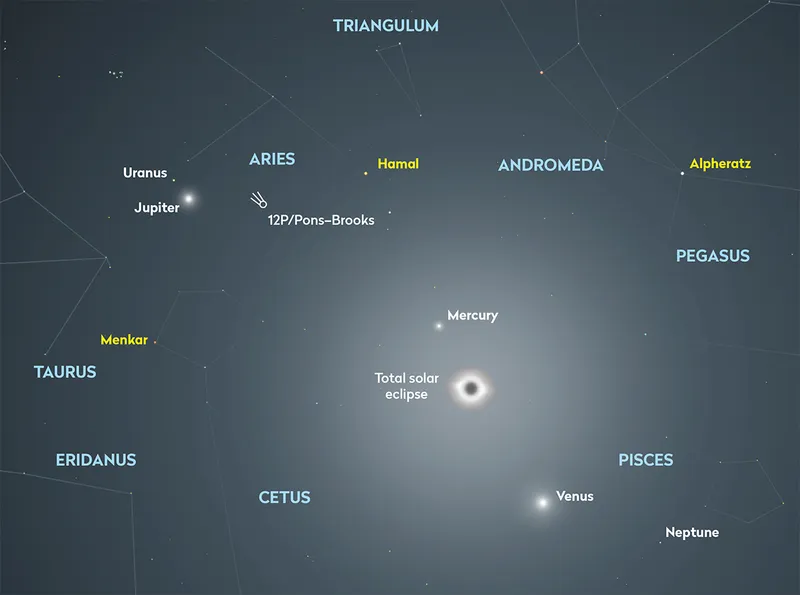An astrophotographer managed to capture an image showing Comet 12P/Pons-Brooks in the sky during the April 8 total solar eclipse, and caught Jupiter and Uranus in the frame too.
If you're a regular visitor to the BBC Sky at Night Magazine website, you'll know that we spent a lot of time in early 2024 covering the Comet 12P/Pons-Brooks story.

It's perhaps been the biggest astronomy story of the of the year so far, apart from of course the April 8 total solar eclipse over North America.
So we were particularly excited at the prospect of Comet Pons-Brooks being visible during the April 8 eclipse.
It felt like these two big stories were culminating in a close embrace during one of the biggest days of the year.
Astrophotographer Stephan Hamel was in Fredericton, New Brunswick, Canada photographing the solar eclipse and captured this image of Comet 12P/Pons-Brooks - along with Jupiter and Uranus - during the event.

But, says Stephan, capturing the comet was something of a shot in the dark (albeit a well-timed and skilful shot in the dark, we say).
"I hesitated to attempt to photograph Comet 12P/Pons-Brooks as I had read in a few places the odds of getting an image of the comet were slim to none and knew things would get real busy for me during totality," Stephan says.
My main objective during totality was to manually operate my main DSLR camera to get as many images as possible during those short two minutes.
"A different camera-lens setup (Nikon D3200+Samyang 135mm) was needed to go after comet 12P/Pons-Brooks which meant more complexity and preparation.
"I also knew the hydrogen alpha telescope that would be running in parallel to get the partial phases would need centring and refocused as soon as third contact happened."
But, not willing to let this put him off, Stephan committed.
"I still decided to give the 12P/Pons-Brooks capture a try, as it was a unique chance and Jupiter was going to provide the perfect reference point in the sky to quickly aim the camera.
"My thoughts were: 'I'll take one image and that's it, then I will enjoy the rest of totality'. That's exactly what I did and it worked!
"I guess estimated the ISO and exposure length, quickly framed the shot with Jupiter and the horizon as reference points and took the image.
"After operating the two DSLRs, I still had time to enjoy the rest of the eclipse totality. In hindsight, I did everything I was recommended not to do for someone's first eclipse!"
And it wasn't until during the days after the eclipse that Stephans Pons-Brooks image really came to light.
"After the eclipse was over, I quickly glanced at the image of the 12P/Pons-Brooks on the back screen of the D3200 and thought it had been overexposed and left it aside while I was working on the other gathered images.
"It was only two weeks later that I finally transferred the image to my computer to give it a fair chance. I reduced the exposure in Lightroom (good thing I shot it in RAW), adjusted the contrast a bit and 12P/Pons-Brooks showed up with Uranus.
"The final tally of my eclipse totality two-minute imaging session was: one corona, diamond ring, prominences, chromosphere, two comets (12P/Pons-Brooks and SOHO-5008) and two planets.
"I imaged more objects in those two minutes than during the previous six cloudy winter months, and all of it from my backyard"
See more of Stephan's work via his Instagram page @stephan_astrophotography.
Details
- Nikon D3200 camera
- Samyang 135mm lens
- Tripod
- ISO 400, f/2.8
- 1 second exposure
- 19h20 UTC
Are you an astrophotographer? Whether amateur or expert, send us your images and they could appear in a future issue of BBC Sky at Night Magazine.
